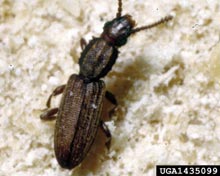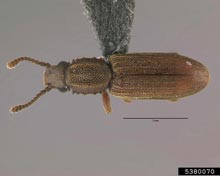
Clemson University, USDA Cooperative Extension Slide Series

Gary Alpert, Harvard University
Grain Beetles
General Description
Two of the most common grain beetles are the sawtoothed grain beetle (Oryzaephilus surinamensis) and the
merchant grain beetle (O. mercator). Virtually identical, Sawtoothed and Merchant Grain Beetles are around
one-tenth of an inch long with flattened bodies well-adapted to crawling into tiny crevices. The name,
Sawtoothed, is derived from the saw-like projections of the thorax.
The larvae of both species are less than one-eighth of an inch long and feed on broken grain and products made from processed grain. The life cycle (egg, larva, pupa and adult stages) is short, producing six to seven generations a year.
General Control
Thorough inspection is needed to discover the source of grain beetle infestations. Problem areas should be
inspected frequently to discover stored product pests before infestations flourish. Spilled food and grain products
such as flour and cereal behind and under shelving can be a source of infestation. Sanitation and proper storage
of grain products help prevent and control grain beetles. Temperatures below 0 F for 24 hours will kill all stages
of grain beetles. Although detection and elimination of infested product is the key to controlling these and other
stored product pests, crack-andcrevice applications of appropriately labeled insecticides are sometimes
warranted.









